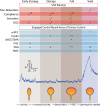Enhancing Neuroplasticity via vagus nerve stimulation to improve urinary dysfunction after spinal cord injury: a perspective
- PMID: 40542413
- PMCID: PMC12181832
- DOI: 10.1186/s42234-025-00178-5
Enhancing Neuroplasticity via vagus nerve stimulation to improve urinary dysfunction after spinal cord injury: a perspective
Abstract
One problematic and undertreated consequence of spinal cord injury (SCI) is urinary dysfunction. Treatment is usually conservative, involving regulation of fluid intake and scheduled bladder emptying through intermittent catheterization. These interventions provide symptomatic relief but are associated with recurrent urinary tract infections and increased risk of kidney disease. Neuromodulation has been used to counteract aberrant signals, such as bladder overactivity, but has yet to address other symptoms, such as urethral sphincter tonic activity or poor bladder compliance. Combining rehabilitation with vagus nerve stimulation (VNS), which is known to engage neuromodulatory nuclei to promote synaptic neuroplasticity and recovery, has emerged as a potential therapy to restore function after neurological injury including SCI. Our perspective is that a congruent strategy of pairing VNS with bladder function after incomplete SCI can promote neuroplastic changes in spared neural pathways to strengthen neural control of bladder function.
Keywords: Neurogenic bladder; Neuroplasticity; Spinal cord injury; Vagus nerve stimulation.
© 2025. The Author(s).
Conflict of interest statement
Declarations. Ethics approval and consent to participate: No direct interactions with human participants were conducted for this manuscript. As such, no IRB was required. Animal procedures were approved by the University of Texas at Dallas IACUC (14–10). Consent for publication: All authors approved the submission and publication of this manuscript. Competing interests: The authors declare no competing interests.
Figures

Similar articles
-
Probiotics for preventing urinary tract infection in people with neuropathic bladder.Cochrane Database Syst Rev. 2017 Sep 8;9(9):CD010723. doi: 10.1002/14651858.CD010723.pub2. Cochrane Database Syst Rev. 2017. PMID: 28884476 Free PMC article.
-
Single-incision sling operations for urinary incontinence in women.Cochrane Database Syst Rev. 2017 Jul 26;7(7):CD008709. doi: 10.1002/14651858.CD008709.pub3. Cochrane Database Syst Rev. 2017. Update in: Cochrane Database Syst Rev. 2023 Oct 27;10:CD008709. doi: 10.1002/14651858.CD008709.pub4. PMID: 28746980 Free PMC article. Updated.
-
Cortical intermittent theta burst stimulation and neurogenic bladder management after traumatic incomplete spinal cord injury: A case report.J Spinal Cord Med. 2025 Jun 18:1-4. doi: 10.1080/10790268.2025.2514320. Online ahead of print. J Spinal Cord Med. 2025. PMID: 40530917
-
Vagus nerve stimulation for focal seizures.Cochrane Database Syst Rev. 2022 Jul 14;7(7):CD002896. doi: 10.1002/14651858.CD002896.pub3. Cochrane Database Syst Rev. 2022. PMID: 35833911 Free PMC article.
-
Signs and symptoms to determine if a patient presenting in primary care or hospital outpatient settings has COVID-19.Cochrane Database Syst Rev. 2022 May 20;5(5):CD013665. doi: 10.1002/14651858.CD013665.pub3. Cochrane Database Syst Rev. 2022. PMID: 35593186 Free PMC article.
References
-
- Anderson KD. Targeting Recovery: Priorities of the Spinal Cord-Injured Population. J Neurotrauma. 2004;21:1371–83. - PubMed
-
- Chabungbam M, Roy S, Venkataraman S. Management of neurogenic bladder in traumatic spinal cord injury. Indian Journal of Physical Medicine & Rehabilitation. 2023;33:62–62.
-
- Cunningham JT, Mifflin SW, Gould GG, Frazer A. Induction of c-Fos and ΔFosB Immunoreactivity in Rat Brain by Vagal Nerve Stimulation. Neuropsychopharmacology. 2008;33:1884–95. - PubMed
Publication types
Grants and funding
LinkOut - more resources
Full Text Sources
